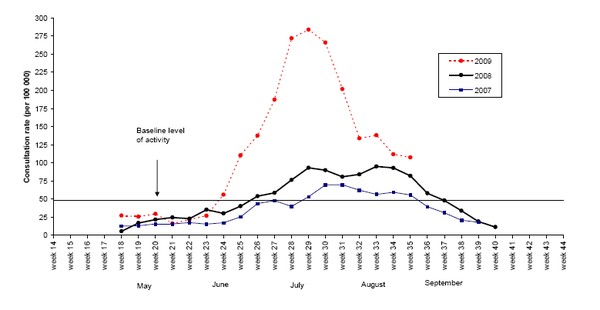Pandemic Influenza (H1N1) 09 Swine Flu - Update 149

There are a total of 3150 confirmed cases of Pandemic Influenza (H1N1) 09 swine flu, compared with 3146 on 7 September. These are people who have returned a positive laboratory test for pandemic influenza (H1N1) 09. The actual number of cases of Pandemic Influenza (H1N1) 09 will be significantly higher, as only a small proportion of people with symptoms have been tested.
The number of deaths from Pandemic Influenza (H1N1) swine flu where swine flu was a primary cause is 17. Other deaths are being investigated by the Coroner's office.
The number of swine flu cases appears to be abating in New Zealand but the virus is still circulating. It is important people maintain good hygiene habits: covering coughs and sneezes, regular hand washing and staying at home while sick.
Numbers of people in hospitals with the Pandemic Influenza (H1N1) 09
As at midday today, only one person was reported to be in hospital with pandemic Influenza (H1N1) 09 or its complications.
Healthline Calls
The number of influenza-related calls to Healthline has reduced over recent weeks but remains significantly higher than at the same time last year. The total number of calls [of all call types] answered by Healthline nurses is about 15 percent above normal levels.
Australian Situation
For the number of confirmed cases in Australia, go to the Australian Government's Department of Health and Ageing website at:
http://www.healthemergency.gov.au/internet/healthemergency/publishing.nsf/Content/updates
International Update from the World Health Organization
http://www.who.int/en/
The World Health Organisation (WHO) advises evidence from multiple outbreak sites demonstrates that the H1N1 pandemic virus has rapidly established itself and is now the dominant influenza strain in most parts of the world. The pandemic will persist in the coming months as the virus continues to move through susceptible populations.
Close monitoring of viruses by a WHO network of laboratories shows that viruses from all outbreaks remain virtually identical. Studies have detected no signs that the virus has mutated to a more virulent or lethal form.
Likewise, the clinical picture of pandemic influenza is largely consistent across all countries. The overwhelming majority of patients continue to experience mild illness. Although the virus can cause very severe and fatal illness, including in young and healthy people, the number of such cases remains small.
While these trends are encouraging, large numbers of people in all countries remain susceptible to infection. Even if the current pattern of usually mild illness continues, the impact of the pandemic during the second wave could worsen as larger numbers of people become infected.
WHO is advising countries in temperate parts of the southern hemisphere to remain vigilant. As experience has shown, localized “hot spots” of increasing transmission can continue to occur even when the pandemic has peaked at the national level. Countries in the northern hemisphere are advised to prepare for a second wave of pandemic spread. Countries with tropical climates, where the pandemic virus arrived later than elsewhere, are also advised to prepare for an increasing number of cases.
